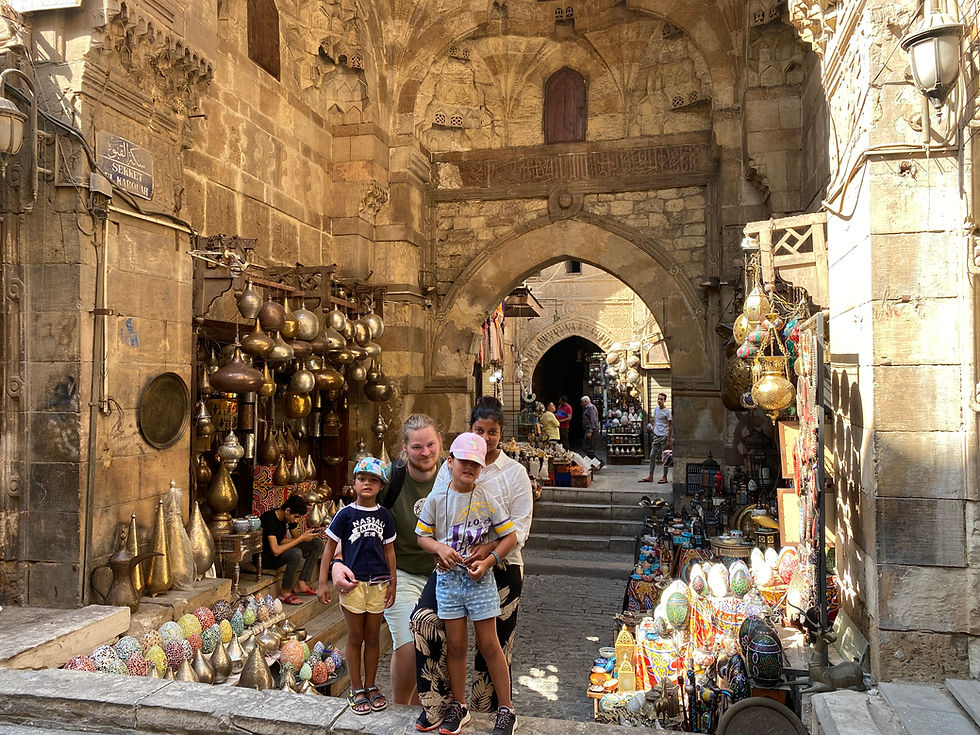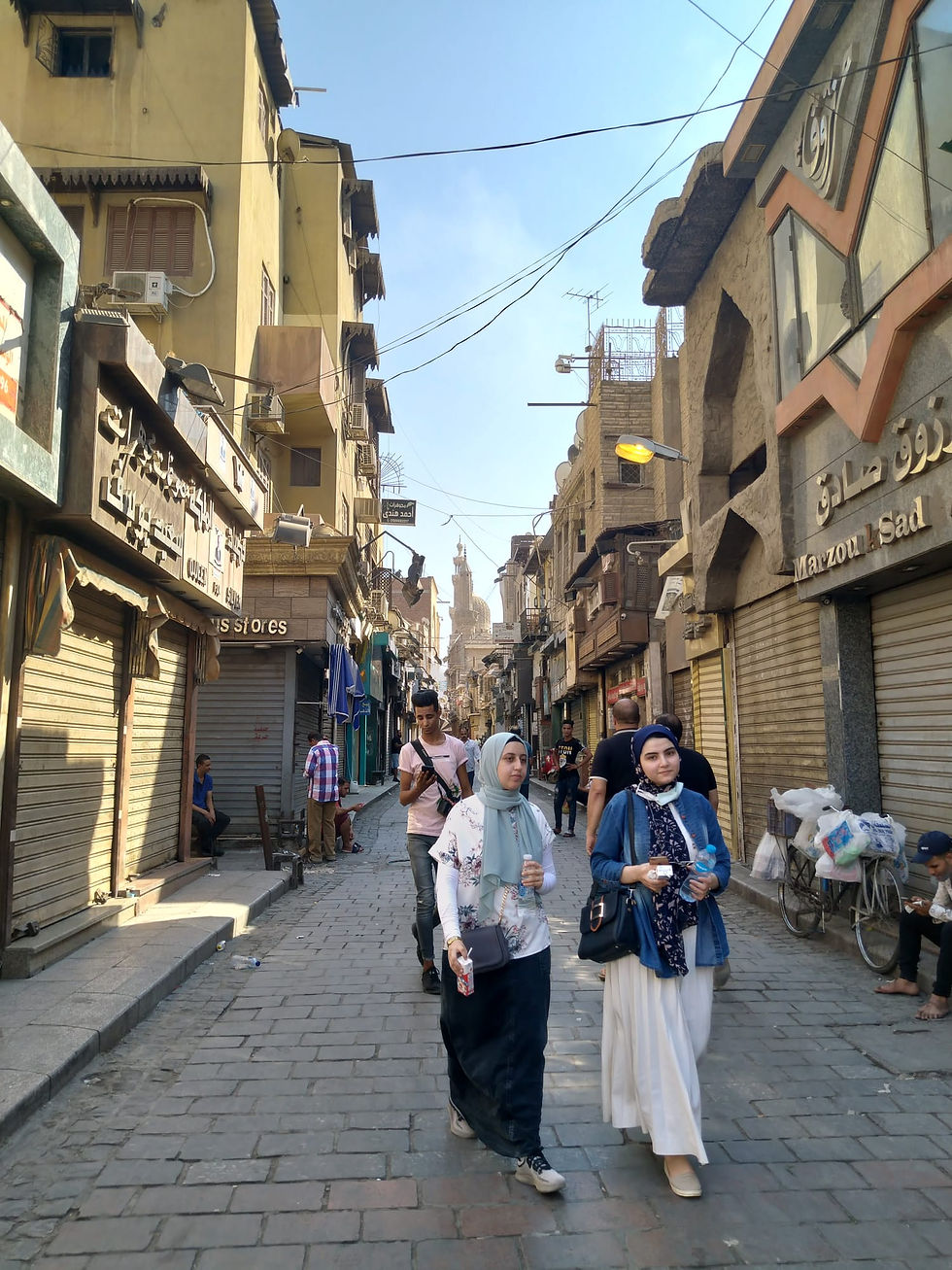Islamic Cairo with kids
- Backpackingkids

- Oct 3, 2021
- 6 min read
After a morning walk through Cairo and a visit to the museum, we have a second activity planned.
Even before we had booked the trip, I came into contact with Mohammed Swefy via-via. Swefy is an Egyptian from Cairo, working as a tour guide with a love for Islam and its history. We have already made a nice deal via the internet. The starting point was to see old Islamic Cairo. Last minute we made our appointment a little later in the day, because of the heat and because our water rats cannot be beaten out of the pool.
Swefy asks if we can come to the Al-Azhar mosque, he is waiting for us. We fix a taxi and leave for the specified place. We drive deeper and deeper into Cairo, and although there were no tourists to be found, I'm sure you won't find them here at all. The taxi driver asks us twice; 'are you sure?'
We are used to something so I'm not worried. It is a half hour drive and the girls use mom to close their eyes for a while. We always tell them when we get into a taxi to close our eyes, so that they have more energy later. The good thing is that they now know that and want to do it themselves. That's the first win when you travel with kids!
Indeed, Swefy is waiting for us at the gate of the mosque. He receives us and we walk in. Barefoot of course, something the kids don't mind at all 😂. Shamila has to cover up, although she was already wearing long trousers and a long-sleeved shirt, because the least you can do is adapt as much as possible to the country where you are a guest).
We get a tour from Swefy and a supervisor from the 'external relations department of the Al-Azhar mosque'. Both gentlemen talk fondly about the complex, founded in 971. This is two years after the foundation of Cairo. The mosque is completely empty, no one to be seen. No tourists and we have the complex to ourselves. The first thing you notice is the beautiful white tiled floor in the open space. The tiles are baking in the sun, but are cool enough. It turns out to be a special stone, comes from Mecca and was donated by Saudi Arabia.
We get a lesson in Islamic architecture, the functions of the building and see the beautiful beauty in this ancient building reflected in everything. The girls have questions, and that's the great thing about kids, they're open to anything.

The manner of prayer is shown and explained to them. The girls listen carefully, they are not biased. They don't think it's 'weird', at most the remark 'but we just fold hands and close our eyes, don't we?' Only when you are open to someone else you realize how much we have in common. And let's focus on what we have in common and not on what separates us. I am a Christian but am open to learn from others. That's what makes life so valuable, that's what I try to pass on to my children. Be open to everything, discover, learn and yet remain true to yourself.
Swefy talks with passion, he prefers to do this. But because there are hardly any tourists, he works in the Al-Azhar library (university). When I hear that people on the street call him doctor and I ask him about it, he remains humble and indicates that he loves it when people visit 'his' Cairo. Swefy is one of the many graduates who can't find the job they were trained for.

After visiting this beautiful mosque he takes us to the other side, to the Khan El-Khalili. This is the largest souk in the world, located in Cairo, the capital of Egypt. The market originated at the end of the fourteenth century and in the past was popular with the itinerant trade caravans from Africa, the Middle East and Asia. The souk takes its name from Emir Djaharks el-Khalili, a powerful Mamluk prince, who first built the market in 1382. In the days of Ottoman Egypt, the market was also known as the Turkish Bazaar.
At our request (read the children) we first have something to eat. The market goes like almost everything in Egypt, through the metal detection gates. The last time I was in Cairo, there had been an attack a few weeks earlier, so my visit was accompanied by a lot of security protocols (read a lot of police and a lot of checkpoints. The last attack took place in 2009 and since then it has been slowly the souk has become less and less an establishment, at the moment only a metal detection gate at the entrances.
Swefy takes us to a shop where they make 'Egyptian pancakes'. You can find this restaurant here. The card gives you two options, namely sweet and savory. By 'sweet' we mean Egyptian pancakes and by 'savory' Egyptian pizzas.
Jaira opts for a savory pizza, according to the menu with Turkish cheese. Joëlla opts for a pancake with banana. Furthermore, pancakes with coconut and cream are ordered. Swefy eats with us of course, always nice to have your guide eat with you. The five of us attack the four dishes. I can assure you, it's lovely here. In no way does it resemble a pizza or pancake. It's magically delicious and the pancakes are crispy. It is in fact between a pancake and puff pastry, provided with a delicious filling with, in this case, coconut, banana or cream. And, of course, with a layer of powdered sugar.
Jaira's pizza is actually the same, but savory. She loves it! She even enjoys eating the green peppers in between. During dinner we have nice conversations with Swefy and we enjoy the fact that these girls are 'just' enjoying themselves in a local tent among the Egyptians. Highly recommended!

Then the question is asked by one of the children who you know will come, but hope that it will not be until the hotel. "Mommy I have to go to the toilet." The restaurant has no toilet, at least Swefy says 'don't do it here'. He asks if he should walk to another shop with our daughter, he knows a good place. The friendliness is to his credit, but I prefer to walk along. A few narrow alleys further, the children are indeed allowed to go inside to pee. Problem solved, although Jaira indicated to 'hold it up for a while' after seeing the toilet.
When we have finished eating, we walk into the market for a while. There is a slight separation between the touristic part of the souk and the part that is mainly intended for the local population: to the right of the 'main entrance' people mainly sell souvenirs, water pipes, gold and silver, while in the left part mainly clothing, all kinds of utensils , toys and spices to the locals. We walk across the market and bend a little to the left, towards the al-Mu'izz street.

This complex is called the Qalawun complex and it is huge! Built by Sultan al-Mansur Qalawun in 1284-1285. Here you will find a hospital, a madrassa (school) and a mausoleum. It is widely regarded as one of the most important monuments of Islamic Cairo and Mamluk architecture, notable for the size and scope of its charitable activities and the richness of its architecture.

The streets around it are beautiful and hardly any tourists come to this part of the city. They did come before, but today that is unique. Egypt was just recovering from political turmoil when Covid arrived. The children visibly enjoy the narrow streets, the shops, the palaces and the attention they receive from the Egyptians.


After a long walk we walk with Swefy back to our starting point. He wants to show us one more thing. Behind the Al-Azhar mosque is another market, according to him the real local market. Well, that may be right. You will not easily encounter a tourist in the streets here. The dirt roads are full of rubbish. The butchers chop the meat in front of their door. The children suddenly see cadavers hanging, for the first time in their lives. But they don't think it's really weird. They thought it smelled, and they're certainly right about that.
Everyone really looks at you here, you feel you are becoming very small here. After a few blocks we stop at a tiny shop. Here they sell handmade boxes. Wooden boxes with beautiful patterns made from sanded shells. You see this often in the Middle East, in Jordan we were thrown to death with it. Jaira really wants one for her earrings. She knows that she has some money (has her own wallet) and also knows that buying something now means that it will no longer be possible later. She selects one and proudly buys her Egyptian souvenir with the pocket money she received from grandmother.
In the next blog we will take you to the pyramids of Giza and Djoser!












Comments